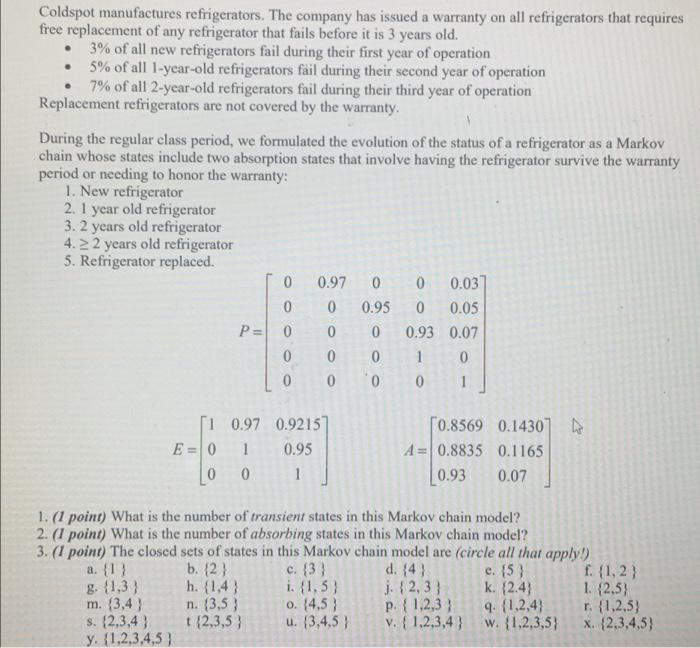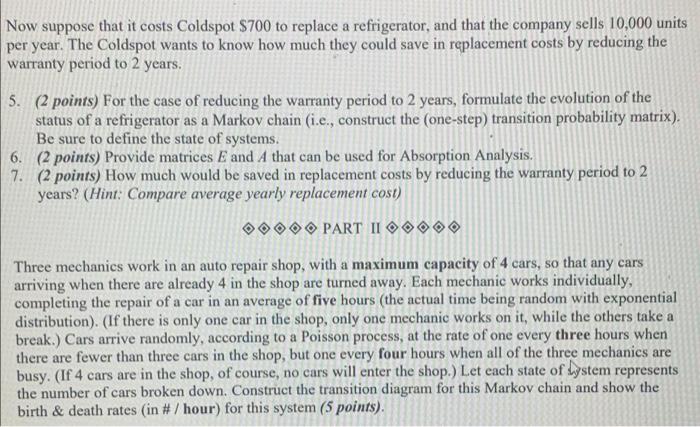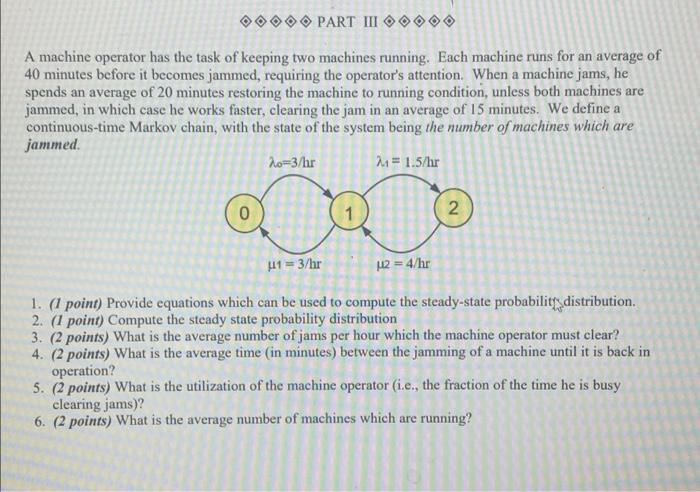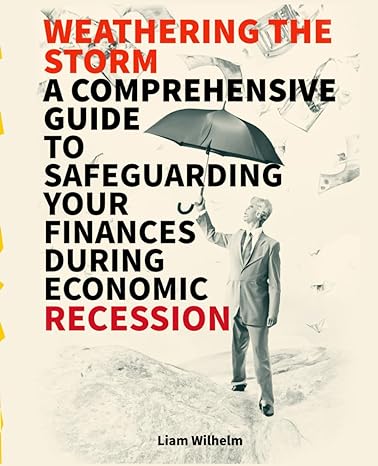Coldspot manufactures refrigerators. The company has issued a warranty on all refrigerators that requires free replacement of any refrigerator that fails before it is 3 years old. 3% of all new refrigerators fail during their first year of operation 5% of all 1-year-old refrigerators fail during their second year of operation 7% of all 2-year-old refrigerators fail during their third year of operation Replacement refrigerators are not covered by the warranty. During the regular class period, we formulated the evolution of the status of a refrigerator as a Markov chain whose states include two absorption states that involve having the refrigerator survive the warranty period or needing to honor the warranty: 1. New refrigerator 2. 1 year old refrigerator 3. 2 years old refrigerator 4. 2 years old refrigerator 5. Refrigerator replaced. 0 0.97 0 0 0.03 0 0 0.95 0 0.05 P= 0 0 0 0.93 0.07 0 0 0 1 0 0 0 0 0 1 1 0.97 0.9215] E = 0 1 0.95 0 0 1 0.8569 0.1430 A=0.8835 0.1165 (0.93 0.07 1. (1 point) What is the number of transient states in this Markov chain model? 2. (1 point) What is the number of absorbing states in this Markov chain model? 3. (1 point) The closed sets of states in this Markov chain model are (circle all that apply!) a. [1] b. {2} c. {3} d. {4} e. {5 f. {1,2) g. {1,3) h. {1,4) i. {1,5} j. {2,3} k. (2.4) 1. {2,5) m. (3,4) n. (3,5) o. {4,5) p. {1,2,3 9. {1,2,4) r. {1,2,5) S. (2,3,4) t {2,3,5) u. (3,4,5) v. {1,2,3,4) W. {1,2,3,57 X. (2,3,4,5) y. {1,2,3,4,5) d. {4} 4. (1 point) The minimal closed sets of states in this Markov chain model are (circle all that apply! a. {1} b. {2} c. {3} e: {5 f. {1,2} g. {1,3) h. {1,4) i. {1,5} j. {2,3) k. (2.4) 1. {2,5) m. {3,4) n. 3,5) 0. {4,5) p. {1,2,3) 9. {1,2,4) r. {1,2,5) s. {2,3,4) t {2,3,5} u. {3,4,5) v. {1,2,3,4} w. {1,2,3,5} X. {2,3,4,5) y. {1,2,3,4,5) Now suppose that it costs Coldspot $700 to replace a refrigerator, and that the company sells 10,000 units per year. The Coldspot wants to know how much they could save in replacement costs by reducing the Warranty period to 2 years. 5. (2 points) For the case of reducing the warranty period to 2 years, formulate the evolution of the status of a refrigerator as a Markov chain (i.e., construct the (one-step) transition probability matrix). Be sure to define the state of systems. 6. (2 points) Provide matrices E and A that can be used for Absorption Analysis. 7. (2 points) How much would be saved in replacement costs by reducing the warranty period to 2 years? (Hint: Compare average yearly replacement cost) PART II Three mechanics work in an auto repair shop, with a maximum capacity of 4 cars, so that any cars arriving when there are already 4 in the shop are turned away. Each mechanic works individually, completing the repair of a car in an average of five hours (the actual time being random with exponential distribution). (If there is only one car in the shop, only one mechanic works on it, while the others take a break.) Cars arrive randomly, according to a Poisson process, at the rate of one every three hours when there are fewer than three cars in the shop, but one every four hours when all of the three mechanics are busy. (If 4 cars are in the shop, of course, no cars will enter the shop.) Let each state of lystem represents the number of cars broken down. Construct the transition diagram for this Markov chain and show the birth & death rates (in # /hour) for this system (5 points) PART III A machine operator has the task of keeping two machines running. Each machine runs for an average of 40 minutes before it becomes jammed, requiring the operator's attention. When a machine jams, he spends an average of 20 minutes restoring the machine to running condition, unless both machines are jammed, in which case he works faster, clearing the jam in an average of 15 minutes. We define a continuous-time Markov chain, with the state of the system being the number of machines which are jammed ho=3/hr 21 = 1.5/hr 2 41 = 3/hr H2 = 4/hr 1. (1 point) Provide equations which can be used to compute the steady-state probability distribution. 2. (1 point) Compute the steady state probability distribution 3. (2 points) What is the average number of jams per hour which the machine operator must clear? 4. (2 points) What is the average time (in minutes) between the jamming of a machine until it is back in operation? 5. ( points) What is the utilization of the machine operator (i.e., the fraction of the time he is busy clearing jams)? 6. (2 points) What is the average number of machines which are running? Coldspot manufactures refrigerators. The company has issued a warranty on all refrigerators that requires free replacement of any refrigerator that fails before it is 3 years old. 3% of all new refrigerators fail during their first year of operation 5% of all 1-year-old refrigerators fail during their second year of operation 7% of all 2-year-old refrigerators fail during their third year of operation Replacement refrigerators are not covered by the warranty. During the regular class period, we formulated the evolution of the status of a refrigerator as a Markov chain whose states include two absorption states that involve having the refrigerator survive the warranty period or needing to honor the warranty: 1. New refrigerator 2. 1 year old refrigerator 3. 2 years old refrigerator 4. 2 years old refrigerator 5. Refrigerator replaced. 0 0.97 0 0 0.03 0 0 0.95 0 0.05 P= 0 0 0 0.93 0.07 0 0 0 1 0 0 0 0 0 1 1 0.97 0.9215] E = 0 1 0.95 0 0 1 0.8569 0.1430 A=0.8835 0.1165 (0.93 0.07 1. (1 point) What is the number of transient states in this Markov chain model? 2. (1 point) What is the number of absorbing states in this Markov chain model? 3. (1 point) The closed sets of states in this Markov chain model are (circle all that apply!) a. [1] b. {2} c. {3} d. {4} e. {5 f. {1,2) g. {1,3) h. {1,4) i. {1,5} j. {2,3} k. (2.4) 1. {2,5) m. (3,4) n. (3,5) o. {4,5) p. {1,2,3 9. {1,2,4) r. {1,2,5) S. (2,3,4) t {2,3,5) u. (3,4,5) v. {1,2,3,4) W. {1,2,3,57 X. (2,3,4,5) y. {1,2,3,4,5) d. {4} 4. (1 point) The minimal closed sets of states in this Markov chain model are (circle all that apply! a. {1} b. {2} c. {3} e: {5 f. {1,2} g. {1,3) h. {1,4) i. {1,5} j. {2,3) k. (2.4) 1. {2,5) m. {3,4) n. 3,5) 0. {4,5) p. {1,2,3) 9. {1,2,4) r. {1,2,5) s. {2,3,4) t {2,3,5} u. {3,4,5) v. {1,2,3,4} w. {1,2,3,5} X. {2,3,4,5) y. {1,2,3,4,5) Now suppose that it costs Coldspot $700 to replace a refrigerator, and that the company sells 10,000 units per year. The Coldspot wants to know how much they could save in replacement costs by reducing the Warranty period to 2 years. 5. (2 points) For the case of reducing the warranty period to 2 years, formulate the evolution of the status of a refrigerator as a Markov chain (i.e., construct the (one-step) transition probability matrix). Be sure to define the state of systems. 6. (2 points) Provide matrices E and A that can be used for Absorption Analysis. 7. (2 points) How much would be saved in replacement costs by reducing the warranty period to 2 years? (Hint: Compare average yearly replacement cost) PART II Three mechanics work in an auto repair shop, with a maximum capacity of 4 cars, so that any cars arriving when there are already 4 in the shop are turned away. Each mechanic works individually, completing the repair of a car in an average of five hours (the actual time being random with exponential distribution). (If there is only one car in the shop, only one mechanic works on it, while the others take a break.) Cars arrive randomly, according to a Poisson process, at the rate of one every three hours when there are fewer than three cars in the shop, but one every four hours when all of the three mechanics are busy. (If 4 cars are in the shop, of course, no cars will enter the shop.) Let each state of lystem represents the number of cars broken down. Construct the transition diagram for this Markov chain and show the birth & death rates (in # /hour) for this system (5 points) PART III A machine operator has the task of keeping two machines running. Each machine runs for an average of 40 minutes before it becomes jammed, requiring the operator's attention. When a machine jams, he spends an average of 20 minutes restoring the machine to running condition, unless both machines are jammed, in which case he works faster, clearing the jam in an average of 15 minutes. We define a continuous-time Markov chain, with the state of the system being the number of machines which are jammed ho=3/hr 21 = 1.5/hr 2 41 = 3/hr H2 = 4/hr 1. (1 point) Provide equations which can be used to compute the steady-state probability distribution. 2. (1 point) Compute the steady state probability distribution 3. (2 points) What is the average number of jams per hour which the machine operator must clear? 4. (2 points) What is the average time (in minutes) between the jamming of a machine until it is back in operation? 5. ( points) What is the utilization of the machine operator (i.e., the fraction of the time he is busy clearing jams)? 6. (2 points) What is the average number of machines which are running










